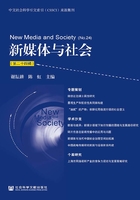
狂欢理论视阈下网络表情符号的传播与反思
彭肇一 孙发友
摘要:在巴赫金狂欢理论的视阈下,在社交媒体平台流行起来的网络表情符号具有与狂欢节类似的“诙谐感”。狂欢的全民性、仪式性、更新与交替精神与网络表情符号的传播具有内在的一致性。网络表情符号的流行折射出大众参与、民意表达、谋求话语权力、宣泄情绪等社会文化心理。其背后呈现出的群体极化、社交窘境、道德迷失和监管漏洞,仍然值得我们反思。
关键词:网络表情符号 狂欢理论 巴赫金 社会文化心理
Propagation and Reflection on Emoticons under the Perspective of Theory of Carnival
Peng Zhaoyi Sun Fayou
Abstract Under the perspective of Bakhtin's Theory of Carnival,Emoticons,which prevails on social media,has a sense of “humor” that resembles the Carnival.There is an intrinsic consistency between the carnival featured by its popularity,rituality,spirit of renewal and alternation and the prevalence of Emoticons.The prevalence of Emoticons refect a series of social and cultual psycological phenomenons such as public participation,public expression,seeking for the discourse power and catharsis of emotions,etc..The Group polarization,social interaction paradox,moral deficiency and regulatory vulnerability,which reflected by the prevalence of Emoticons,still worth paying attention to.
Keywords Emoticon;Theory of Carnival;Bakhtin;Social and Cultual Psycology
在社交媒体时代,网络表情符号已成为人们在沟通交流中除文字、视频之外的第三种语言。由于其具备视觉性及趣味性,在社交平台上得以迅猛发展。近年来,随着公民公共事务参与意识的不断提高,网络表情符号开始广泛地应用于公共事件的讨论中。
表情符号以明星、语录、动漫、影视截图等为素材,匹配适合的文字,用于网络交流中表达特定的情感。其发展分为三个阶段:第一阶段是简单符号期,键盘符号通过各种组合方式形成类似人脸表情的符号,对脸部表情的再现弥补了文字交流中无法感知对方表情的缺陷。第二阶段是系统表情阶段,即 emoji表情,大多以表达各种情绪作为主题,将情感做表达夸大化的呈现。第三阶段是自定义表情,即由个体自己制作表情,由最初的线性标记演化成为动态形象,建构个体的表达空间。在社交平台上网络表情符号的频繁使用,已成为重要的文化景观和传播现象,既是公众参与公共事件的见证,也反映了社会文化和社会心理的变革。